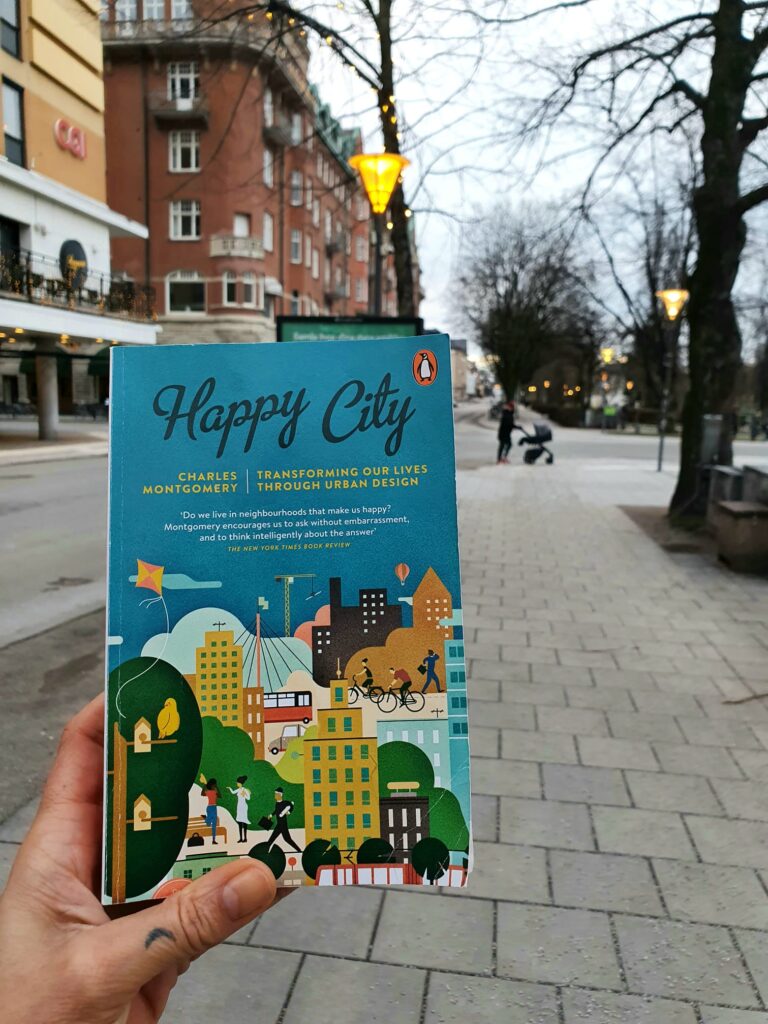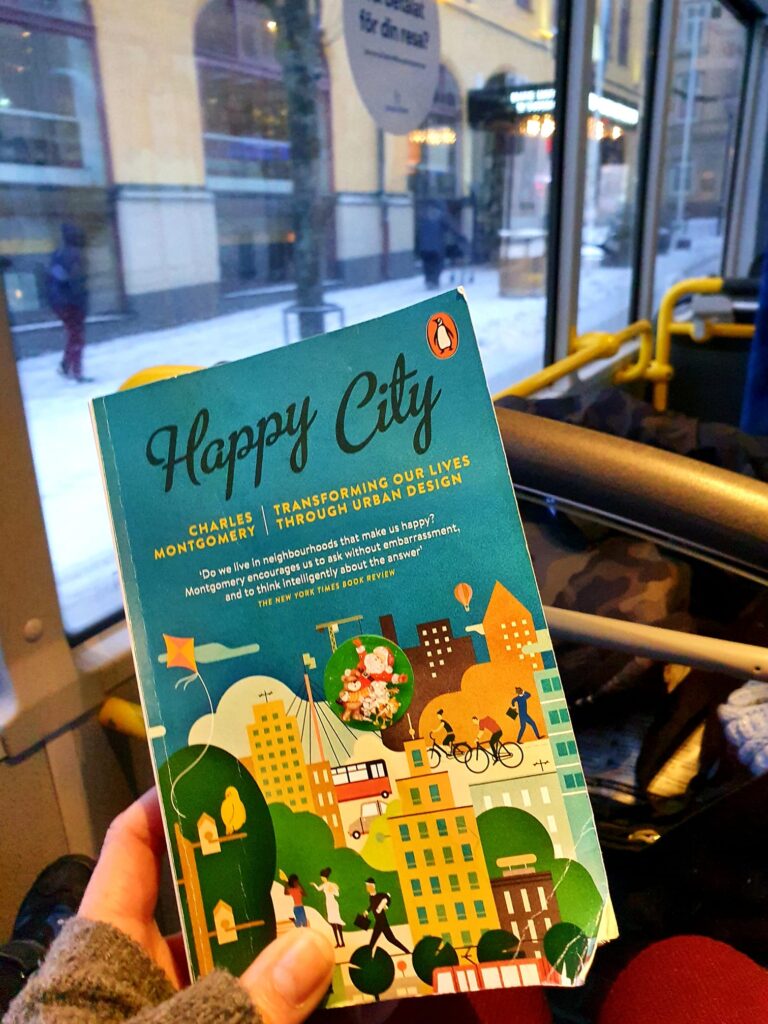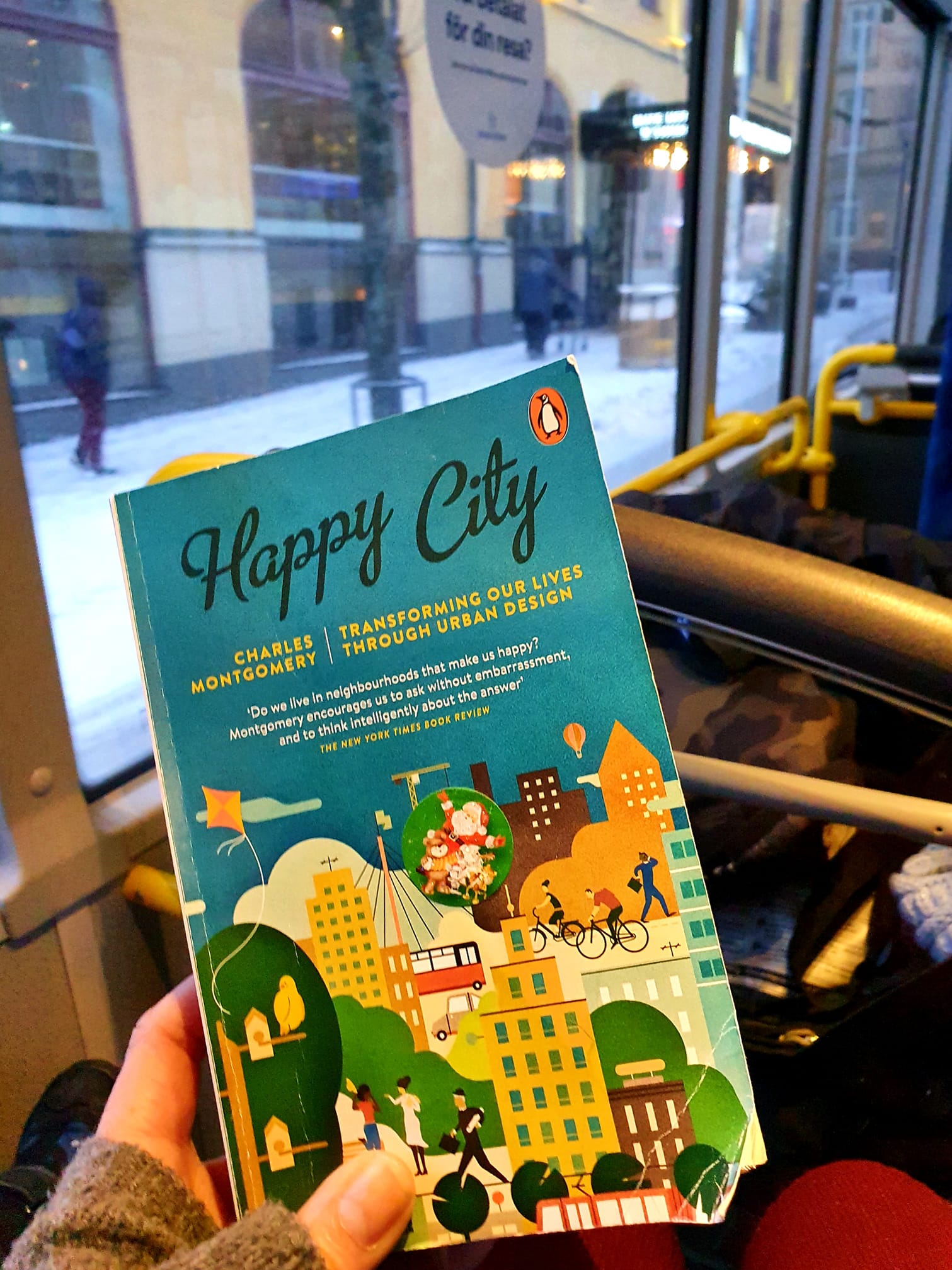For the month of January we collaborated with Laura at Urbanism Book Club in reading and discussing Happy City: Transforming Our Lives Through Urban Design by Charles Montgomery.
We hope you enjoy our discussion and questions below and please feel free to join the dialogue on this and future books @urbanismbookclub and @pedestrianspace.

Question 1: What do you think of measuring happiness in a city by asking “Would you get your wallet back if you dropped it in the street?”
Answer Pedestrianspace: I think this is a very interesting question to think about and not always so easy to answer. The value in having social trust in your community is really powerful. However, I do have some skepticism that it typically correlates with happiness in reality. There are some cities where perhaps there is objectively a high level of safety and social trust, but perhaps a low degree of actual warmth and social engagement – elements I also find very important in terms of being happy in a place. That said, I do think the sense of relaxation and trust in an environment and a community is an extremely important factor for a truly humane society.
When I was living in Stockholm many years ago, I lost my ID and debit card so figured I would never see them again, but someone put them in the mail and sent to me- which at the time surprised me but also was in line with a fairly high degree of safety etc in Swedish cities I suppose. However, I would not say it made me ‘happier’. In a way it connected to my overall feeling of safety in the city but I’m not sure it enhanced my happiness. In fact, I find Stockholm to be, socially, a kind of notoriously difficult city- I eventually left for Berlin in fact. In Berlin I didn’t necessarily feel safer and probably watched my belongings more carefully, but I was happier.
Answer parCitypatory: Interestingly, I often feel that social trust is highest in “poor” or informal neighbourhoods. Here, people tend to know each other and watch out for each other. Whether you get your wallet back usually depends a lot on how you act in these neighbourhoods. If you interact, buy something in the corner store and behave respectfully, I think chances are pretty good.
In anonymous, hectic city centres, however, I think the chances of getting your wallet back are much lower. But again, this depends a lot on each street. Where there are many “eyes on the streets”, as Jane Jacobs calls them, people might shout out and help you. These tend to be the streets with less through-traffic, children playing and mixed uses. Usually, they make for the best neighbourhoods in terms of liveability and happiness!
Question 2: Which ingredients would you put on the recipe list for the Happy City?
Answer Pedestrianspace:
- Proximity to all amenities (the 15/20 minute city)
- Very walkable with a great deal of green space woven through the city
- A sense of safety at basically all hours
- The built environment, city spaces and local culture are accessible and enjoyable for all ages
- There is a sense of cleanliness and respect for the city (conveyed both through how the municipality as well as the citizens care for the city and its spaces)
- Reliable, accessible, clean, affordable public transportation
- Community / Seasonal public events (i.e. fairs, markets, holiday events)
- Affordability (great spectrum income diversity-not a city of ‘have’ and have nots’ with stark polarity of wealth and poverty)
Answer parCitypatory: I fully agree and would add the following ingredients:
- Street festivals
- Space for pedestrians and bikes
- Possibility for children to play on the streets
- Mixed use and mixed audience
- Spaces for pets (https://parcitypatory.org/2020/02/06/pet-friendly-cities/)
- Opportunities to interact and participate
- Interventions of Tactical Urbanism (https://parcitypatory.org/2020/07/31/tactical-urbanism/)
- Also, according to Jane Jacobs, these are the four magic ingredients: mixed uses, small blocks, aged building and density (https://parcitypatory.org/2020/08/28/neighbourhood-ballet/)
Question 3: In referring to Jan Gehl’s work in Copenhagen, Montgomery observes (pg. 156) that “…by redesigning city space, you can actually transform city culture.” What are some examples you have seen of such transformations in your own communities or cities visited?
Answer parCitypatory: In Mexico City, creating pedestrian space on big crossings by colouring in the sidewalks and the spaces around them, a first step towards transforming city culture has been made. Cars now have less space to turn a corner, which is why they slow down more. Pedestrians enjoy walking more and feel much safer. This enhancement of pedestrian culture is something Mexico City urgently needs.
Answer Pedestrianspace: In Örebro there is a contemporary public art biennial called OpenART. During the three summer months, you can experience art all over the city. The municipality organizes it in partnership with key organizations and local and international artists are featured. Currently it is on hold due to pandemic restrictions, but in previous years OpenART was a draw for international as well as domestic tourists and of course creates incredibly interesting and engaging spaces for local residents through the summer months. The city itself becomes a “walking museum” and many of the exhibits involve engaging spaces where you can participate in an activities.
In the city’s own words, “OpenART Biennale is based on a conviction that a creative society builds bridges rather than walls.”
“It is a biennial that revolts against traditional urban spaces, encourages creativity, and gives us the opportunity to experience the city from completely new perspectives. Works of art invade the city’s streets, squares, parks and waterways, taking over cultural scenes, shopping centres, building facades and Örebro Castle. When contemporary art becomes this accessible to the public, it promotes a dialogue about what art means to society.” -http://openart.se/2019/en/about-openart/
There are guided tours, pedagogical programmes as well as exhibition areas specifically designed for children as well, to allow them to explore their creativity. Additionally, the entire exhibition and all activities are free!
So while it is a temporary and seasonal event, it is a really fantastic way to experience with the city during the summer months both as a visitor and a resident. It promotes engaging with public spaces all over the city as well as with the community.
Question 4: Montgomery quotes a study (pg. 85) that found that “…for a single person, exchanging a long commute for a short walk to work has the same effect on happiness as finding a new love.” Have you experienced major shifts in life and well being connected to walking?
Answer parCitypatory: During the pandemic, a daily walk has kept me sane, I think! Walking is also the best way to meet neighbours, notice changes in the neighbourhood and foster your sense of orientation. Whenever I move to a new place or just go somewhere on holiday, I try to make walkability my main criteria for choosing where to live.
Answer Pedestrianspace: I have lived in several walkable communities before but I would say that the city I currently live in has set a new standard for what I value. I can reach everything in 15 to 20 minutes by foot and this has felt both radical and so incredibly practical. While shifting into this type of living has been seamless, it has been major in the sense of really enhancing our quality of life.


